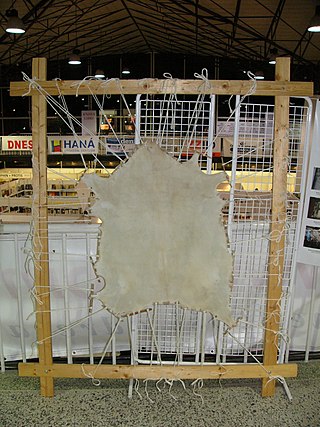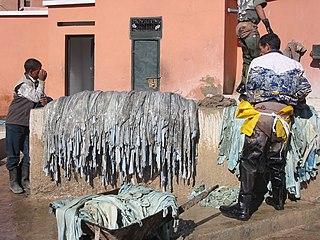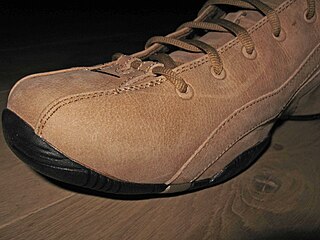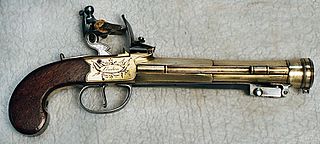Related Research Articles

An acid is a molecule or ion capable of either donating a proton (i.e. hydrogen ion, H+), known as a Brønsted–Lowry acid, or forming a covalent bond with an electron pair, known as a Lewis acid.
Hydrolysis is any chemical reaction in which a molecule of water breaks one or more chemical bonds. The term is used broadly for substitution, elimination, and solvation reactions in which water is the nucleophile.

Leather is a strong, flexible and durable material obtained from the tanning, or chemical treatment, of animal skins and hides to prevent decay. The most common leathers come from cattle, sheep, goats, equine animals, buffalo, pigs and hogs, and aquatic animals such as seals and alligators.

Parchment is a writing material made from specially prepared untanned skins of animals—primarily sheep, calves, and goats. It has been used as a writing medium for over two millennia. Vellum is a finer quality parchment made from the skins of young animals such as lambs and young calves.

Sulfuric acid or sulphuric acid, known in antiquity as oil of vitriol, is a mineral acid composed of the elements sulfur, oxygen, and hydrogen, with the molecular formula H2SO4. It is a colorless, odorless, and viscous liquid that is miscible with water.
In chemistry, hydronium (hydroxonium in traditional British English) is the common name for the aqueous cation H3O+, the type of oxonium ion produced by protonation of water. It is often viewed as the positive ion present when an Arrhenius acid is dissolved in water, as Arrhenius acid molecules in solution give up a proton (a positive hydrogen ion, H+) to the surrounding water molecules (H2O). In fact, acids must be surrounded by more than a single water molecule in order to ionize, yielding aqueous H+ and conjugate base. Three main structures for the aqueous proton have garnered experimental support: The Eigen cation, which is a tetrahydrate, H3O+(H2O)3; the Zundel cation, which is a symmetric dihydrate, H+(H2O)2; and the Stoyanov cation, an expanded Zundel cation, which is a hexahydrate: H+(H2O)2(H2O)4. Spectroscopic evidence from well-defined IR spectra overwhelmingly supports the Stoyanov cation as the predominant form. For this reason, it has been suggested that wherever possible, the symbol H+(aq) should be used instead of the hydronium ion.

Tanning is the process of treating skins and hides of animals to produce leather. A tannery is the place where the skins are processed.

Corrosion is a natural process that converts a refined metal into a more chemically stable oxide. It is the gradual deterioration of materials by chemical or electrochemical reaction with their environment. Corrosion engineering is the field dedicated to controlling and preventing corrosion.

A corrosive substance is one that will damage or destroy other substances with which it comes into contact by means of a chemical reaction.

Piranha solution, also known as piranha etch, is a mixture of sulfuric acid (H2SO4) and hydrogen peroxide (H2O2). The result of the mixture gives rise to a strong union of two acids called per-hexa-sulfuric acid (H4SO6) that is used to clean organic residues off substrates. Because the mixture is a strong oxidizing agent, it will decompose most organic matter, and it will also hydroxylate most surfaces (by adding –OH groups), making them highly hydrophilic (water-compatible). This means the solution can also easily dissolve fabric and skin, potentially causing severe damage and chemical burns in case of inadvertent contact.

Nubuck is top-grain leather that has been sanded or buffed on the grain side, or outside, to give a slight nap of short protein fibers, producing a velvet-like surface. It is resistant to wear, and may be white or coloured.

The leather manufacturing process is divided into three sub-processes: preparatory stages, tanning and crusting. All true leathers will undergo these sub-processes. A further sub-process, surface coating may be added into the sequence. The list of operations that leathers undergo vary with the type of leather.
The deliming operation in leather processing is a drum/paddle or pit based operation where two main objectives are met:

Red rot is a degradation process found in vegetable-tanned leather.

The conservation and restoration of silver objects is an activity dedicated to the preservation and protection of objects of historical and personal value made from silver. When applied to cultural heritage this activity is generally undertaken by a conservator-restorer.
Russia leather is a particular form of bark-tanned cow leather. It is distinguished from other types of leather by a processing step that takes place after tanning, where birch oil is worked into the rear face of the leather. This produces a leather that is hard-wearing, flexible and resistant to water. The oil impregnation also deters insect damage. This leather was a major export good from Russia in the 17th and 18th centuries because of its high quality, its usefulness for a range of purposes, and the difficulty of replicating its manufacture elsewhere. It was an important item of trade for the Muscovy Company. In German-speaking countries, this leather was also known by the name Juchten or Juften.

The conservation and restoration of shipwreck artifacts is the process of caring for cultural heritage that has been part of a shipwreck. Oftentimes these cultural artifacts have been underwater for a great length of time. Without conservation, most artifacts would perish and important historical data would be lost. In archaeological terms, it is usually the responsibility of an archaeologist and conservator to ensure that material recovered from a shipwreck is properly cared for. The conservation phase is often time-consuming and expensive, which is one of the most important considerations when planning and implementing any action involving the recovery of artifacts from a shipwreck.
The conservation and restoration of fur objects is the preservation and protection of objects made from or containing fur. These pieces can include personal items like fur clothing or objects of cultural heritage that are housed in museums and collections. When dealing with the latter, a conservator-restorer often handles their care, whereas, for the public, professional furriers can be found in many neighborhoods.

The conservation and restoration of historic firearms is preventative care, damage repair, stabilization, replacement of missing components, and potentially the return of the firearm to firing capabilities. It requires an understanding of the different types of historic firearms and knowledge in the care and treatment of organic and inorganic materials, as firearms are composed of many types of materials, from wood to metal, that are fitted together.

Leather is created when an animal skin or hide is chemically treated in a process called tanning to preserve them for long term use as material for clothing, handbags, footwear, furniture, sports equipment and tools. Alligator leather is also commonly used to create similar items as mentioned above.
References
- ↑ "Leather Properties and Characteristics". muirhead.co.uk. Retrieved 25 June 2016.
- ↑ Dirksen, Vicki (1 November 1997). "The Degredation [sic] and Conservation of Leather". Journal of Conservation and Museum Studies . 3. doi: 10.5334/jcms.3972 .
- ↑ Handwerk, R. (2021). Evidence of Fur and Leather Clothing, Among World’s Oldest, Found in Moroccan Cave. smithsonianmag.com/science-nature/evidence-of-fur-and-leather-clothing-among-worlds-oldest-found-in-moroccan-cave-180978689/
- ↑ Kite, Marion and Thomson, Roy. 2006. Conservation of Leather and related materials. Oxford: Elsevier. 73-77
- ↑ Western Australia Museum. (n.d.). Deterioration. https://manual.museum.wa.gov.au/conservation-and-care-collections-2017/leather/deterioration#:~:text=Leather%20is%20affected%20adversely%20by,as%20in%20the%20collagen%20molecules.
- ↑ Waterer, J. W. 1971. A Guide to the Conservation and Restoration of Objects Made Wholly or in Part of Leather . New York: Drake Publishers, Inc.
- ↑ "Removing Mould from Leather - CCI Notes 8/1". Cci-icc.gc.ca. 2013-09-17. Archived from the original on 2016-03-04. Retrieved 2016-06-25.
- ↑ Canadian Conservation Institute. 1992. "Care of alum, vegetable, and mineral tanned leather." CCI Notes, 8(2), 1-4.
- ↑ Kite, Marion and Thomson, Roy. 2006. Conservation of Leather and related materials. Oxford: Elsevier. 126
- ↑ Kite, Marion and Thomson, Roy. 2006. Conservation of Leather and related materials. Oxford: Elsevier. 124-126
- ↑ Storch, P. S. 1987. "Curatorial care and the handling of skin materials, Part 1: Tanned objects." Conservation Notes, 17, 1-4.
- ↑ Kite, Marion and Thomson, Roy. 2006. Conservation of Leather and related materials. Oxford: Elsevier. 121-123
- ↑ "Materials and techniques: past and present", p 121-122, Conservation of Leather and Related Materials, Marion Kite, Roy Thomson - 2006 - Antiques & Collectibles